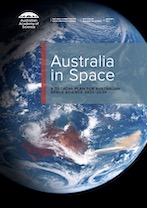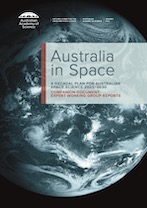Australia in Space presents a ten-year plan for Australian space science, with recommendations and strategies to advance national interests and priorities in space; growing the innovation economy, developing sovereign capability and improving the lives of all Australians.
The plan makes three headline recommendations:
A national research priority in space science is established that aligns with civil and defence sovereign industry capability requirements, encourages discovery and innovation, and helps build capacity for national benefit and international impact.
A Lead Scientist role is established in the Australian Space Agency with responsibility for space science policy settings. The role should include responsibility for providing strategic science policy advice, facilitating cross-sector engagement and international collaboration, and fostering capacity development initiatives.
Commitment to and investment in an ongoing national space program, enabled by space missions that advance science, stimulate technical innovation, address national priorities, grow capability and inspire citizens.
These headline recommendations are underpinned by an additional six recommendations that can be found in the plan.
The plan is accompanied by a companion document that contains reports prepared by 12 expert working groups that provide the basis for the findings of the plan.

Download the report
(PDF, 5.9 MB)

Download the companion report
(PDF, 3.9 MB)
Read the Academy’s media release
Now is an exciting time to be involved with space. Space-derived activities and services are integral to Australia’s economic, environmental and national security, with increasingly diverse and open-market participation in space activities catalysing transformative opportunities but also amplifying risks. Australia aims to exploit new opportunities by growing an internationally competitive space industry which will also build innovation capability and address strategic needs. Key to this is a sustainable space sector built on a foundation of excellence in science and technology.
Space science – the science of exploration and use of space to generate new knowledge, disruptive innovation and practical benefit – is a fundamental enabler for space industry and applications. It underpins the space programs of our partners and our own space aspirations. Australian space science research has established a world-class reputation in many areas. It engages with international space programs and is critical for growing our space capability and mitigating risks. However, Australia’s space R&D sector faces several challenges which impact the development and competitiveness of our space economy.
Our vision is for Australia to be a respected partner in the global community of spacefaring nations, leading our own space missions with Australian science teams and Australian-built payloads and spacecraft systems. These missions will propel breakthrough science and technologies, and Australian expertise will contribute to the most significant international space missions. These activities will accelerate development of sovereign space capability and help train and grow a world-class workforce of professionals and technologists to feed the new opportunities arising in the burgeoning high value industry, research and applications sectors.
To achieve this vision, this plan makes the following headline recommendations.
These headline recommendations underpin our plan, and are supported by six further recommendations, which seek to develop the following initiatives.
Successful implementation of the plan will result in a range of benefits, including:
© 2026 Australian Academy of Science